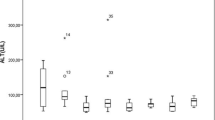Abstract.
HCFC-123 (2,2-dichloro-1,1,1-trifluoroethane), a substitute for the banned chlorofluorocarbons (CFCs), is a structural analogue of the well-known hepatotoxicant halothane. The objectives of these experiments were to investigate (1) whether, like halothane, multiple exposure increases the risk of HCFC-123-induced liver toxicity, and (2) whether ethanol, a potent CYP2E1 inducer, potentiates the liver toxicity of HCFC-123. In experiment 1, male Hartley guinea-pigs were exposed twice a week to 5000 ppm HCFC-123 (4 h) during 3 weeks followed by 2 weeks recovery, and then re-exposed or not during 4 h to 5000 ppm HCFC-123. A group with a single exposure to 5000 ppm HCFC-123 and a control group were also included. In experiment 2, guinea-pigs received 5 or 10% ethanol in drinking water during 12 days before a single 4-h exposure to 5000 ppm HCFC-123. A group receiving 10% only, a group exposed once to 5000 ppm HCFC-123 but not pre-treated with ethanol and a control group were also included. In both experiments, the liver toxicity was assessed, 24 h post-exposure, by the serum activities of alanine aminotransferase (ALT) and isocitrate dehydrogenase (ICDH) as well as by histopathology. In experiment 2 the urinary excretion rate of the main metabolites trifluoroacetic acid (TFA) and chlorodifluoroacetic acid (CDFA) was assessed and CYP2E1 activity was measured by the chlorzoxazone metabolic ratio. Multiple exposure to 5000 ppm HCFC-123 did not cause greater liver damage than a single exposure (ALT, ICDH 3-fold control values). At this level of exposure the liver lesions were totally reversible within two weeks. Ethanol consumption produced CYP2E1 induction, increased urinary excretion of both HCFC-123 metabolites (more than 2-fold the rate measured in the non-induced group) and markedly increased the liver toxicity of HCFC-123 as shown by the serum liver enzyme activities (ALT 8.5-fold increase, ICDH 13-fold increase), and the histopathology. The necrosis was predominantly localised in the intermediate zone of the hepatic lobules with vacuolisation of the centrilobular zones. The effects associated with 10% ethanol pre-treatment were less marked than those observed with ethanol 5% and could be explained by the remaining blood ethanol levels causing an inhibition of HCFC-123 biotransformation. Significant correlations were obtained between the serum enzyme activities, the histopathology, the excretion rate of the metabolites and CYP2E1 activity. It can be concluded that (1) multiple exposure to HCFC-123 did not increase the liver toxicity of HCFC-123 in this experimental model, and (2) chronic ethanol consumption, known to be CYP2E1 inducer, strongly enhanced the biotransformation of HCFC-123 and its liver toxicity.
Similar content being viewed by others
Author information
Authors and Affiliations
Additional information
Electronic Publication
Rights and permissions
About this article
Cite this article
Hoet, P., Buchet, JP., Sempoux, C. et al. Potentiation of 2,2-dichloro-1,1,1-trifluoroethane (HCFC-123)-induced liver toxicity by ethanol in guinea-pigs. Arch Toxicol 76, 707–714 (2002). https://doi.org/10.1007/s00204-002-0389-8
Received:
Accepted:
Issue Date:
DOI: https://doi.org/10.1007/s00204-002-0389-8




